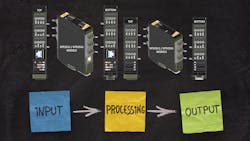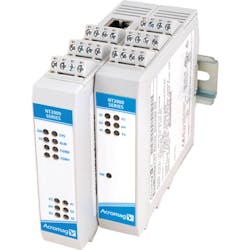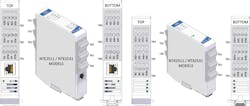Acromag's Latest I/O Modules Offer Greater Flexibility with a Mix of Signal Types
What you’ll learn:
- How Ethernet I/O modules are superior in performance.
- How Acromag I/O modules are used.
- Key specs of Acromag’s I/O modules.
In Industry 4.0, I/O (input/output) modules play a critical role in enabling data exchange between machines, systems, and processes. I/O modules are electronic devices that act as an interface between the physical world (e.g., sensors and actuators) and the digital/analog world (e.g., a computer or a control system). Modules can be utilized for any number of applications, including data acquisition, security, machine control, communications, etc.
Acromag's new multifunction I/O modules can handle those applications and more (Fig. 1). The company's NT2510 and NT2530 Ethernet remote I/O modules are designed to support I/O expansion of up to 64 channels with a mix of signal types on a single IP address. These modules are part of its BusWorks NT Series, which provides a rugged and flexible I/O solution for distributed I/O applications in harsh industrial environments.
The BusWorks NT Series modules support various analog and digital signal types, including voltage, current, thermocouple, RTD, discrete input/output, and counter/timer. They use Modbus TCP/IP protocol to communicate with a master controller, which can be a PLC, PAC, or PC.
One of the series' key features is its ability to support myriad channels on a single IP address. This makes them well-suited for applications where a large number of I/O points must be monitored and controlled. The modules also can be daisy-chained using RJ-45 connectors, simplifying wiring and reducing installation time.
Module Specs
The NT2510 module is a high-density digital I/O module that provides 32 input and 32 output channels in a compact form factor (Fig. 2). The module features 1500-V isolation between I/O channels and supports up to 2 A per channel. It’s ideal for applications where a large number of discrete I/O points need to be monitored and controlled.
The NT2530 module is a high-density analog I/O module that provides 16 input and 16 output channels in a compact form factor. The module features 1500-V isolation between I/O channels and supports a variety of analog signal types. It targets applications where a large number of analog I/O points must be monitored and controlled.
Both modules can be daisy-chained using RS-485 communication and have an integrated termination resistor for easy installation. They’re also equipped with LED indicators for status and diagnostic information, making it easy to monitor their operation.
High-End Features
The Acromag NT2510 and NT2530 I/O modules provide a high-density and flexible solution for distributed I/O applications. Features for both modules include:
- High density: The high-density design of both modules allows for a large number of I/O points in a small space, reducing installation costs and complexity.
- Flexible signal types: The NT2510 module supports a range of digital signal types, while the NT2530 module supports a variety of analog signal types, including voltage, current, thermocouple, and RTD. This flexibility allows for integration with a wide range of sensors and equipment.
- Isolation: Both modules offer 1500-V isolation between I/O channels, providing protection against ground loops and other electrical interference.
- RS-485 communication: The modules use RS-485 communication to interface with a master controller, which can be a PLC, PAC, or PC. This protocol provides a reliable and efficient means of communication over long distances.
- Daisy-chaining: The modules can be daisy-chained using RS-485 communication, simplifying wiring and reducing installation time.
- Termination resistor: Both modules have an integrated termination resistor, which facilitates installation and reduces the chance of communication errors.
- LED indicators: The modules’ LED indicators for status and diagnostic information make it easy to monitor their operation.
It's clear that the NT series can handle the rigors of industrial environments with its rugged design, reliable operation, and ease of installation. According to Acromag, the I/O modules not only support Modbus TCP/IP communication, but they will include Ethernet/IP and Profinet protocols down the road. With support for all three protocols, selecting between them is easy and can be accessed using any web browser to configure the network settings and I/O operation.
The modules usually function as network slaves. However, they also take advantage of the company’s i2o peer-to-peer communication technology to transfer data directly.
With the latest release of the NT series of I/O modules, we managed to get more information from Acromag about the benefits of using those modules, the design process, and more:
What are the benefits of using Ethernet Remote I/O modules compared to traditional I/O solutions?
There are a number of benefits, which include performance advantages, cost savings, and space savings. Remote I/O often has a wider operating temperature range, superior isolation, and hazardous location approvals for use in harsh environments.
Since a remote I/O module provides the network interface and input/output interface in a single compact unit, it is usually less expensive and smaller than a PLC or an I/O system that requires mating a controller/bus-coupler module, power-supply module, and I/O module together.
It is especially advantageous for a system with a small quantity of I/O channels at a site. A remote I/O module like our NT Series can provide 16 channels of discrete I/O with Modbus/TCP, Ethernet/IP, or Profinet communication in 25 mm (0.98 in.) of DIN rail space.
What is the maximum distance between the module and the controller?
The communication distance between two devices on an Ethernet network is generally limited to 100 meters using a recommended cable. The distance may be extended using hubs, switches, fiber optics, or wireless transmission. A controller could poll data from a remote I/O module located around the world using its IP address.
How many channels can be managed by a single module?
A single NT Series I/O module can interface up to 16 channels. Expansion modules allow for the connection of three additional modules, each with up to 16 channels, for a total of 64 channels on a single IP address.
Is the module compatible with different types of industrial control systems?
NT Series modules currently support Modbus TCP/IP and Ethernet/IP communication protocols. Profinet, OPC UA, and MQTT support are coming soon. So, any control system that can communicate using these protocols is compatible.
What troubles did/do you have developing this platform, and how did you overcome them?
One of the biggest challenges was simply designing using brand new microcontrollers and other ICs. The new technologies offer many advantages, but sometimes the software support utilities were not yet available to support the method in which we wanted to use the microcontroller. So, we had to develop some of the software ourselves. It extended the development time, but in the end, it works exactly as we wanted.
Other challenges involved supply-chain issues brought on by the COVID pandemic. We bought a large supply of critical chips in advance but were surprised by some other broadly used components, usually stocked at multiple electronics distributors, becoming scarce with very long lead times.
About the Author
Cabe Atwell
Technology Editor, Electronic Design
Cabe is a Technology Editor for Electronic Design.
Engineer, Machinist, Maker, Writer. A graduate Electrical Engineer actively plying his expertise in the industry and at his company, Gunhead. When not designing/building, he creates a steady torrent of projects and content in the media world. Many of his projects and articles are online at element14 & SolidSmack, industry-focused work at EETimes & EDN, and offbeat articles at Make Magazine. Currently, you can find him hosting webinars and contributing to Electronic Design and Machine Design.
Cabe is an electrical engineer, design consultant and author with 25 years’ experience. His most recent book is “Essential 555 IC: Design, Configure, and Create Clever Circuits”
Cabe writes the Engineering on Friday blog on Electronic Design.



